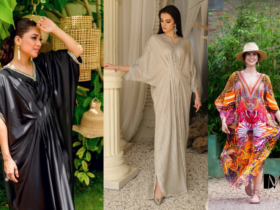Introduction
The dashiki is a vibrant and culturally significant garment that has become a symbol of African heritage and pride. Known for its bold patterns and bright colors, the dashiki has a rich history and a deep cultural meaning. In this article, we will explore the history of the dashiki, its meaning, and its role in modern fashion. We will also answer common questions about the dashiki, including its different styles, such as dashiki shirts and dresses, and how it is worn by men and women.
What Is a Dashiki?
A dashiki is a loose, colorful garment that originated in West Africa. It is traditionally worn by both men and women and is known for its distinctive patterns and bright colors. The dashiki can be worn for various occasions, ranging from casual outings to formal events.
The term “dashiki” comes from the Yoruba word “dàńṣíkí,” which means “shirt.” It is also sometimes referred to as “dancheki” in other West African languages. The dashiki is typically made from cotton fabric and is designed to be comfortable and breathable, making it suitable for the hot African climate.
History of the Dashiki
Origins in West Africa
The dashiki originated in West Africa, where it has been worn for centuries. It was traditionally made from handwoven fabric and decorated with intricate embroidery. The garment was commonly worn by men as a symbol of status and cultural identity.
The Dashiki in the 1960s
The dashiki gained international popularity during the 1960s, particularly in the United States, where it became a symbol of the Black Power movement. African Americans embraced the dashiki as a way to celebrate their African heritage and assert their cultural identity. The dashiki was worn by activists, musicians, and artists, and it became a powerful symbol of pride and resistance.
Evolution of the Dashiki
Over the years, the dashiki has evolved in terms of design and usage. While it remains a traditional garment in many African countries, it has also become a popular fashion statement around the world. Designers have experimented with different fabrics, patterns, and styles, creating modern interpretations of the traditional dashiki.
Dashiki Meaning
The dashiki is more than just a piece of clothing; it carries deep cultural and historical significance. The bold patterns and vibrant colors of the dashiki often have symbolic meanings. For example, certain colors may represent different aspects of life, such as fertility, prosperity, or spirituality.
Wearing a dashiki is a way to honor African heritage and express cultural pride. It is also a symbol of unity and solidarity, as the garment is worn by people of African descent around the world. The dashiki serves as a reminder of the rich cultural traditions of Africa and the resilience of its people.
Types of Dashikis
Dashiki Shirt
The dashiki shirt is the most common style of dashiki. It is a loose-fitting shirt that typically falls to the thighs and features a V-neckline and wide sleeves. Dashiki shirts are often adorned with intricate embroidery and vibrant patterns. They can be worn casually or dressed up for formal occasions.
Dashiki Dress
Dashiki dresses are another popular style of dashiki. These dresses are often designed to be flowing and comfortable, making them suitable for various occasions. Dashiki dresses come in different lengths, from knee-length to floor-length, and are available in a wide range of colors and patterns.
African Dashiki
The term “African dashiki” is often used to refer to traditional dashikis made in Africa. These garments are typically crafted using traditional methods and materials, such as handwoven fabric and natural dyes. African dashikis are highly valued for their authenticity and cultural significance.
Dashiki for Men
Dashikis for men are typically designed to be loose and comfortable, with bold patterns and vibrant colors. They can be worn as casual attire or as formal wear, depending on the occasion. Many men choose to pair their dashikis with matching pants or traditional accessories, such as hats and sandals.
Dashiki for Women
Dashikis for women come in various styles, including shirts, dresses, and skirts. These garments are designed to be stylish and comfortable, making them suitable for everyday wear or special occasions. Women often accessorize their dashikis with jewelry, headwraps, and other traditional accessories.
How to Style a Dashiki
Casual Look
For a casual look, pair a dashiki shirt with jeans or leggings. This combination is comfortable and stylish, making it perfect for everyday wear. Add some traditional jewelry and sandals to complete the look.
Formal Look
To create a formal look, choose a dashiki dress or a well-tailored dashiki shirt. Pair it with dress pants or a skirt, and accessorize with elegant jewelry and shoes. This ensemble is suitable for formal events, such as weddings, parties, or cultural celebrations.
Modern Twist
For a modern twist on the traditional dashiki, experiment with different fabrics and patterns. Look for dashikis made from silk or satin for a more luxurious feel. You can also mix and match different patterns and colors to create a unique and contemporary look.
The Dashiki in Modern Fashion
The dashiki has made a significant impact on modern fashion, both in Africa and around the world. Designers have embraced the dashiki and incorporated it into their collections, creating modern and innovative interpretations of the traditional garment.
Celebrity Endorsements
Many celebrities have been spotted wearing dashikis, helping to popularize the garment in mainstream fashion. Celebrities such as Beyoncé, Chris Brown, and Jidenna have been seen sporting dashikis at events and in their music videos, bringing attention to the cultural significance and stylish appeal of the garment.
Fashion Shows
The dashiki has also made its way onto the runway, with designers showcasing their unique takes on the traditional garment. Fashion shows in Africa and around the world have featured dashikis in various styles, from traditional designs to modern interpretations. These shows highlight the versatility and timeless appeal of the dashiki.
The Dashiki and Cultural Appropriation
Understanding Cultural Appropriation
Cultural appropriation occurs when elements of a minority culture are adopted by members of a dominant culture, often without permission and without understanding or respecting the original cultural context. This can lead to the commodification and misrepresentation of the minority culture.
The Dashiki in the Context of Cultural Appropriation
The dashiki, as a symbol of African heritage and pride, has sometimes been appropriated in ways that strip it of its cultural significance. It is important to approach the wearing and selling of dashikis with respect and understanding of their cultural roots.
Respectful Appreciation
To wear a dashiki respectfully, it is important to educate oneself about its history and significance. Purchasing dashikis from authentic sources that support African artisans and communities can also help ensure that the cultural significance of the garment is honored.
The Dashikis in Education and Awareness
Teaching Cultural Heritage
The dashikis can be a powerful tool for teaching about African heritage and history. Schools and educational programs can use the dashikis to introduce students to the rich cultural traditions of Africa and the significance of traditional garments.
Cultural Programs and Events
Cultural programs and events that celebrate African heritage often feature dashikis. These programs provide opportunities for people to learn about and appreciate the cultural significance of the dashikis and other traditional garments.
Frequently Asked Questions (FAQs)
What Is a Dashikis?
A dashikis is a loose, colorful garment that originated in West Africa. It is traditionally worn by both men and women and is known for its distinctive patterns and bright colors.
What Is the Meaning of the Dashikis?
The dashikis carries deep cultural and historical significance. It is a symbol of African heritage, unity, and cultural pride. The bold patterns and vibrant colors of the dashikis often have symbolic meanings, representing various aspects of life and culture.
What Is the History of the Dashikis?
The dashikis originated in West Africa and gained international popularity during the 1960s, particularly in the United States. It became a symbol of the Black Power movement and a way for African Americans to celebrate their heritage and assert their cultural identity.
How Do You Wear a Dashiki?
A dashikis can be styled in various ways, depending on the occasion. For a casual look, pair a dashikis shirt with jeans or leggings. For a formal look, choose a dashikis dress or a well-tailored dashikis shirt and pair it with dress pants or a skirt. Accessorize with traditional jewelry and shoes to complete the look.
What Are the Different Types of Dashikis?
There are several types of dashikis, including dashikis shirts, dashikis dresses, and African dashikis. Dashikis for men and women come in various styles and designs, making them suitable for different occasions and personal preferences.
Where Can I Buy a Dashikis?
Dashikis can be purchased from various retailers, both online and in physical stores. Many African markets and boutiques offer authentic dashikis made using traditional methods and materials. Online platforms such as Etsy, Amazon, and specialized African clothing stores also offer a wide range of dashikis.
The Cultural Impact of the Dashikis
The dashikis is not just a fashion statement; it is a powerful symbol of cultural identity and pride. It represents a connection to African heritage and serves as a reminder of the rich cultural traditions of Africa. Wearing a dashiki is a way to honor and celebrate this heritage, whether you are of African descent or simply appreciate the beauty and significance of the garment.
A Symbol of Unity
The dashikis is a symbol of unity and solidarity among people of African descent around the world. It is worn during cultural celebrations, festivals, and events, bringing people together to celebrate their shared heritage and identity.
Embracing Cultural Heritage
For many, wearing a dashikis is a way to embrace and celebrate their cultural heritage. It is a statement of pride and a way to connect with their roots. The dashikis serves as a reminder of the resilience and strength of the African people and their rich cultural history.
Promoting Cultural Awareness
By wearing a dashikis, individuals can help promote cultural awareness and appreciation. The garment sparks conversations and educates others about African culture and traditions. It is a way to share the beauty and significance of the dashiki with the world.
The Dashikis in the Diaspora
African Americans and the Dashikis
For many African Americans, the dashikis is a symbol of pride and connection to their African heritage. It was embraced during the Civil Rights Movement as a statement against oppression and a celebration of African culture. Today, it continues to be worn as a symbol of cultural pride and identity.
The Dashikis Around the World
The dashikis is not only popular in Africa and the United States but also around the world. It is worn by people of various backgrounds who appreciate its cultural significance and vibrant design. The dashikis has become a global symbol of African heritage and fashion.
The Dashikis in Art and Media
Representation in Media
The dashikis has been represented in various forms of media, including films, television shows, and music videos. It is often used to depict African culture and heritage and to highlight characters’ connections to their roots.
Artistic Interpretations
Artists have also embraced the dashikis, using its patterns and colors as inspiration for their work. The dashiki’s vibrant designs have influenced visual art, fashion design, and other creative fields.
The Dashikis in Community and Social Movements
Celebrations and Festivals
The dashikis is often worn during cultural celebrations and festivals, such as Kwanzaa, African Independence Day celebrations, and cultural heritage festivals. It serves as a symbol of pride and a way to honor African traditions.
Social Movements
The dashikis has been worn as a symbol of resistance and solidarity in various social movements. It was prominently featured during the Civil Rights Movement and continues to be worn by activists advocating for social justice and equality.
Conclusion
The dashiki is a vibrant and culturally significant garment that has a rich history and deep meaning. From its origins in West Africa to its role in modern fashion, the dashiki continues to be a symbol of African heritage, unity, and pride. Whether worn as a dashiki shirt, dashiki dress, or African dashiki, this garment represents a connection to the past and a celebration of cultural identity.
By understanding the history and significance of the dashiki, we gain a deeper appreciation for this iconic garment and the cultural heritage it represents. Whether you wear a dashiki to honor your heritage, to make a fashion statement, or to support cultural awareness, you are participating in a rich tradition that spans continents and generations.
Call to Action
If you found this article interesting, share it with your friends and family. Let others know about the rich history and significance of the dashiki. And next time you wear a dashiki or see someone wearing one, take a moment to appreciate the story it tells and the cultural pride it represents.


















Leave a Reply
View Comments